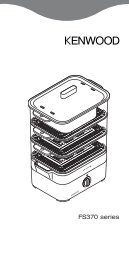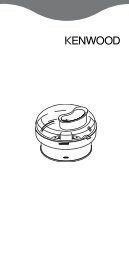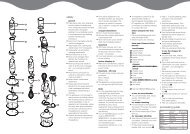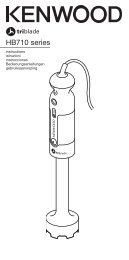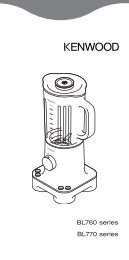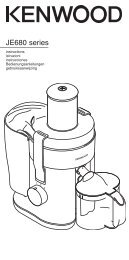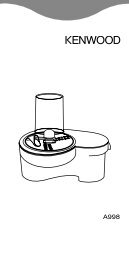54203 FP108 English only - Kenwood
54203 FP108 English only - Kenwood
54203 FP108 English only - Kenwood
Create successful ePaper yourself
Turn your PDF publications into a flip-book with our unique Google optimized e-Paper software.
<strong>FP108</strong> series
1
safety<br />
● The blades and plates are very sharp, handle with care. Always hold the<br />
knife blade by the finger grip at the top, away from the cutting<br />
edge, both when handling and cleaning.<br />
● Always remove the knife blade before pouring contents from the bowl.<br />
● Keep hands and utensils out of the processor bowl whilst connected to the<br />
power supply.<br />
● Switch off and unplug:<br />
● before fitting or removing parts<br />
● after use<br />
● before cleaning<br />
● Never use your fingers to push food down the feed tube. Always use the pusher<br />
supplied.<br />
● Before removing the lid from the bowl:-<br />
● switch off;<br />
● wait until the attachment/blades have completely stopped;<br />
● This machine will be damaged and may cause injury if the<br />
interlock mechanism is subjected to excessive force.<br />
● To prevent damage to the interlock mechanism:-<br />
● Always lock the bowl to the power unit before attempting to fit<br />
the lid.<br />
● Always unlock the lid before attempting to remove the bowl<br />
from the power unit.<br />
● This machine is not intended for use by young children or infirm persons without<br />
supervision.<br />
● Never use an unauthorised attachment.<br />
● Don’t let children play with this machine.<br />
● Never leave the machine on unattended.<br />
● Never use a damaged machine. Get it checked or repaired: see ‘service’.<br />
● Never let the power unit, cord or plug get wet.<br />
● Don’t let excess cord hang over the edge of a table or worktop or touch hot<br />
surfaces.<br />
● Never misuse your food processor and <strong>only</strong> use it for its intended domestic use.<br />
before plugging in<br />
● Make sure your electricity supply is the same as the one shown on the<br />
underside of your appliance.<br />
important - UK <strong>only</strong><br />
● The wires in the cord are coloured as follows:<br />
Blue = Neutral,<br />
Brown = Live.<br />
● This appliance complies with European Economic Community Directive<br />
89/336/EEC.<br />
before using for the first time<br />
1 Remove all packaging including the plastic blade covers from the knife blade.<br />
These covers should be discarded as they are to protect the blade during<br />
manufacture and transit <strong>only</strong>.<br />
2 Wash the parts: see ‘cleaning’.<br />
3 Wrap excess cord around the cord stowage at the back of the appliance.<br />
key<br />
<br />
<br />
<br />
<br />
<br />
<br />
<br />
safety interlock<br />
pusher<br />
feed tube<br />
lid<br />
bowl<br />
food processor drive<br />
on/off/pulse lever<br />
attachments<br />
<br />
<br />
<br />
<br />
<br />
<br />
<br />
<br />
knife blade<br />
shredding plate<br />
slicing plate<br />
plate carrier<br />
spacer<br />
whisk<br />
maxi blend canopy<br />
spatula<br />
to use the food processor<br />
1 Fit the bowl onto the processor base - handle towards the back - lower and<br />
turn clockwise until it locks firmly into place .<br />
2 Add an attachment over the food processor drive.<br />
● Always fit the bowl and attachment onto the machine before adding ingredients.<br />
3 Fit the lid onto the bowl - feed tube towards the back of the machine . Turn<br />
clockwise until the arrow on the lid aligns with the raised line on the body of the<br />
processor .<br />
● Failure to correctly fit the lid will prevent your food processor<br />
from operating.<br />
5 Switch on by moving the on/off/pulse lever to ‘I’ and process until the desired<br />
consistency is achieved OR move the lever to the pulse ‘P’ position to operate<br />
the tool fitted to the bowl in a start/stop action. The pulse feature operates the<br />
motor and keeps it running for as long as it is held in position. This will allow you<br />
to control the texture of various foods eg when processing meat.<br />
6 Switch off and reverse the above procedure to remove the bowl, lid and<br />
attachments.<br />
● The lid can <strong>only</strong> be removed when the on/off/pulse lever is in the ‘0’ position.<br />
important<br />
Your processor is not suitable for crushing or grinding coffee beans, spices or<br />
converting granulated sugar to caster sugar.<br />
When adding almond essence or flavouring to mixtures avoid contact with the<br />
plastic as this may result in permanent marking.<br />
maximum capacities<br />
egg whites 6<br />
chopping meat<br />
300g/10oz<br />
shortcrust pastry flour weight<br />
250g/9oz<br />
yeast dough flour weight<br />
340g/12oz<br />
one stage sponge cake total weight 800g/1lb 12oz<br />
soup with canopy<br />
800ml/1.3pt<br />
using the attachments<br />
knife blade<br />
This blade is the most versatile of all the attachments. The texture you get is<br />
determined by the length of processing time. For coarser textures use the<br />
‘pulse’ feature checking the consistency regularly.<br />
what the knife blade can do.<br />
Raw meat<br />
Make ‘mince’ by trimming raw meat of any excess fat and cutting into 2cm/ 3 ⁄4in<br />
cubes, place into the bowl and operate for approximately 10 seconds or until<br />
the desired texture is achieved. The longer you run the machine the smoother<br />
the texture will be.<br />
Cooked meat<br />
Follow the method for raw meat but process for a shorter time.<br />
Vegetables<br />
Cut the vegetables into pieces approximately 2.5cm/1in in size. Process foods<br />
having a similar texture together eg harder vegetables like carrots and potatoes<br />
or softer ones like mushrooms, tomatoes or cooked vegetables.<br />
Biscuit and breadcrumbs<br />
Drop pieces down the feed tube whilst the machine is operating.<br />
Shortcrust pastry and scones<br />
Put the flour into the bowl. Use fat straight from the refrigerator and cut into<br />
2cm/ 3 ⁄4in cubes. Process until the mixture resembles fine breadcrumbs but take<br />
care not to overprocess. Leave the machine running and add the liquid down<br />
the feed tube. Process until one or two balls of pastry are formed. Chill before<br />
use.<br />
Soups<br />
Purée soups either before or after cooking. Drain the ingredients and place into<br />
the bowl with a small quantity of liquid from the recipe. Process until the desired<br />
consistency has been reached, then add to the remainder of the liquid.<br />
Nuts<br />
Chop nuts for cakes and biscuits by placing into the bowl and processing until<br />
the desired consistency is obtained.<br />
<br />
Citrus press is an optional accessory and may not be included in your pack.<br />
2
Cake making<br />
Sponge type cakes are best made by the ‘all in one method’. All the ingredients<br />
are placed into the bowl and processed until smooth - approximately 10<br />
seconds. A ‘soft tub’ margarine used straight from the refrigerator and cut into<br />
2cm/ 3 ⁄4in cubes should always be used.<br />
Savoury dips/spreads<br />
Place the solid ingredients into the bowl in 2.5cm/1in cubes. Process until finely<br />
chopped. Add the cream etc., and continue to process until the ingredients are<br />
well blended.<br />
Batters<br />
With the knife blade in position place the dry ingredients, egg and a little liquid in<br />
the bowl, process until smooth. Add the remaining liquid down the feed tube<br />
whilst the machine is operating.<br />
Mayonnaise<br />
Place the egg and seasonings into the bowl and mix for a few seconds. With<br />
the machine running gradually add the oil down the feed tube in a slow steady<br />
stream.<br />
Yeast dough<br />
Place the flour, fat and other dry ingredients into the bowl and process for a few<br />
seconds to mix. With the machine running add the liquid mixture down the feed<br />
tube and continue processing until the mixture forms a dough and becomes<br />
smooth in appearance and elastic to touch - this will take 45-60 seconds. Allow<br />
the dough to rise then re-knead for 10 seconds.<br />
whisk<br />
Use for egg whites and cream <strong>only</strong>. The whisk is unsuitable for other recipes.<br />
Make sure the bowl and whisk are free from any traces of grease or egg yolk<br />
when whisking egg whites.<br />
slicing and shredding plates<br />
what the cutting plates can do.<br />
slicing plate - slices carrots, potato, cabbage, cucumber, courgette, beetroot,<br />
onion.<br />
shredding plate - grates cheese, carrot, potato and foods of a similar texture.<br />
to assemble the plate carrier<br />
1 Clip the spacer onto the end of the plate carrier .<br />
2 Select the desired plate and fit into the carrier with the cutting side uppermost.<br />
● Locate one end of the plate under the rim and press the other end into position<br />
it will <strong>only</strong> fit one way round .<br />
important<br />
When using the slicing and shredding plates the spacer must be clipped into<br />
position on the end of the carrier.<br />
using the cutting plates<br />
shredding plate<br />
Cut pieces of food to fit the feed tube. Fill the tube almost to the top and push<br />
down using the pusher with an even pressure whilst the machine is running.<br />
Longer shreds can be obtained by stacking pieces horizontally in the feed tube<br />
eg carrot.<br />
slicing plate<br />
If necessary cut food to fit the feed tube. Core foods such as apples and<br />
peppers. Pack the food in an upright position in the feed tube. The height<br />
should be slightly shorter than the feed tube. Using the pusher, push down with<br />
an even pressure whilst the machine is running.<br />
hints<br />
● Use fresh ingredients.<br />
● Don’t cut food up too small. Fill the feed tube fairly full, this prevents food from<br />
slipping sideways during processing.<br />
● When slicing or shredding: food placed upright comes out shorter than food<br />
placed horizontally.<br />
● After using a cutting plate there will always be a small amount of waste on the<br />
plate or in the food.<br />
● Do not allow food to build up to the underside of the plate - empty regularly.<br />
● Push food down the feed tube using an even pressure.<br />
maxi blend canopy<br />
When blending, use the maxi blend canopy in conjunction with the knife blade.<br />
It allows you to increase the liquid processing capacity of the bowl and improve<br />
the chopping performance of the blade.<br />
1 Place the canopy into the bowl over the knife blade - do not push down .<br />
2 Fit the lid - the lid will ensure that the canopy is located at the correct height .<br />
citrus press (optional attachment)<br />
The citrus press is used to juice citrus fruit ie oranges, lemons, limes and<br />
grapefruits.<br />
1 Fit the bowl onto the processor. Add the strainer and turn clockwise until the fin<br />
on the strainer aligns with the mark on the processor body .<br />
2 Attach the cone onto the drive shaft turning until it drops all the way down .<br />
3 Cut the fruit in half. Switch on and press the fruit onto the cone.<br />
cleaning<br />
● Always switch off and unplug before cleaning.<br />
● Never let the power unit, cord or plug get wet.<br />
● Handle blades and cutting plates with care - they are extremely sharp.<br />
● Some foods will discolour the plastic. This is perfectly normal. It won’t harm the<br />
plastic or affect the flavour of your food. Rubbing with a cloth dipped in<br />
vegetable oil helps remove discolouring.<br />
power unit<br />
● Wipe with a damp cloth, then dry.<br />
● Wrap excess cord around the cord stowage at the back of the appliance.<br />
other parts<br />
● Wash by hand, then dry thoroughly.<br />
● All attachments can be washed on the top rack of your dishwasher.<br />
service and customer care<br />
●<br />
If the cord is damaged it must, for safety reasons, be replaced by <strong>Kenwood</strong> or<br />
an authorised <strong>Kenwood</strong> repairer.<br />
UK<br />
If you need help with:<br />
● using your appliance or<br />
● servicing, spare parts or repairs (in or out of guarantee)<br />
call <strong>Kenwood</strong> on 023 9239 2333 and ask for Customer Care. Have your model<br />
number ready – it’s on the underside of your appliance. Alternatively, contact<br />
your authorised <strong>Kenwood</strong> repairer: look in YELLOW PAGES under ‘Electrical<br />
appliance repairs’.<br />
Eire<br />
See our advertisement in Golden Pages.<br />
other countries<br />
Contact the shop where you bought your appliance.<br />
guarantee - UK <strong>only</strong><br />
If your food processor goes wrong within one year from the date you bought it,<br />
we will repair it (or replace it if necessary) free of charge provided:<br />
● you have not misused, neglected or damaged it;<br />
● it has not been modified (unless by <strong>Kenwood</strong>);<br />
● it is not second-hand;<br />
● it has not been used commercially;<br />
● you have not fitted a plug incorrectly; and<br />
● you supply your receipt to show when you bought it.<br />
This guarantee does not affect your statutory rights.<br />
3
ecipes<br />
mackerel pâté<br />
200g/8oz smoked mackerel cut into 2cm/ 3 ⁄4in cubes<br />
100g/4oz cream cheese cut into 2cm/ 3 ⁄4in cubes<br />
few drops of lemon juice<br />
} optional<br />
salt and pepper<br />
Fit the knife blade in the bowl, add all the ingredients and blend until smooth.<br />
shortcrust pastry<br />
250g/9oz plain flour<br />
125g/4 1 ⁄2oz mixture of lard and margarine, cut into 2cm/ 3 ⁄4in cubes, taken<br />
straight from the refrigerator<br />
pinch salt<br />
45ml/9tsp water<br />
Fit the knife blade to the bowl, add the flour, fat and salt. Process until the<br />
mixture resembles fine breadcrumbs (approximately 6 seconds - don’t<br />
overprocess as it will continue mixing when the water is added.)<br />
With the machine running add the water down the feed tube and process until<br />
one or two balls of pastry are formed. Remove the pastry from the bowl and<br />
gather together by hand to prevent overprocessing. Wrap in cling film and chill<br />
for 30 minutes before using.<br />
beef cobbler<br />
450g/1lb lean braising steak, cut into 2.5cm/1in cubes<br />
1 onion, peeled<br />
25g/1oz butter<br />
400g tin chopped tomatoes<br />
125g/4 1 ⁄2oz mushrooms, wiped<br />
2.5ml/ 1 ⁄2tsp mixed herbs<br />
salt and pepper<br />
topping<br />
200g/8oz self raising flour<br />
75g/3oz suet<br />
50g/2oz cheddar cheese<br />
90ml/6tbsp water approximate<br />
With the knife blade in position separately chop the onion, mushrooms and<br />
meat (chop the meat in two batches). Melt the butter add the onion and meat<br />
and fry for approximately 10 minutes. Add the tomatoes, mushrooms and<br />
seasoning and simmer gently for approximately 20 minutes. Transfer the<br />
mixture to an ovenproof dish.<br />
Grate the cheese. Place the knife blade in position, add the cheese, flour and<br />
suet. Mix together then with the motor running add sufficient water down the<br />
feed tube to make a firm dough. Roll out on a lightly floured surface to<br />
approximately 1cm/ 1 ⁄2in thick and cut out circles using a 6cm/2 1 ⁄2in cutter.<br />
Arrange the scones on top of the meat overlapping slightly. Brush with milk<br />
then bake at 200°C, 400°F or gas mark 6 for 30 minutes.<br />
layered salad<br />
1/4 small white cabbage, stalk removed<br />
1/2 small red cabbage, stalk removed<br />
1/2 cucumber<br />
2 eating apples, cored<br />
2 carrots, peeled<br />
100g/4oz cheddar cheese<br />
50g/2oz walnuts<br />
Separately slice the cabbage, cucumber and apples then place in layers in a<br />
salad bowl. Separately grate the carrot and cheese and add in layers to the<br />
bowl. Using the knife blade chop the walnuts and sprinkle on top of the salad.<br />
Serve with your favourite salad dressing.<br />
victoria sandwich<br />
150g/6oz ‘soft tub’ margarine, cut into 2cm/ 3 ⁄4in cubes, taken straight from the<br />
refrigerator<br />
150g/6oz caster sugar<br />
3 eggs<br />
150g/6oz self raising flour<br />
jam<br />
icing sugar<br />
Using the knife blade, place the margarine, sugar, eggs and flour into the bowl.<br />
Process for a few seconds (approximately 5-8 seconds) until smooth.<br />
Place the mixture into two greased 18cm/7in sandwich tins and bake in a preheated<br />
oven at 190°C/375°F/gas mark 5 for approximately 25 minutes until<br />
golden and springs back when lightly touched. Turn onto a wire rack and allow<br />
to cool, then sandwich together with jam and dredge with icing sugar.<br />
mushroom soup<br />
200g/8oz white button mushrooms<br />
1 small onion<br />
50g/2oz butter<br />
250ml/ 1 ⁄2pt white stock<br />
25g/1oz plain flour<br />
250ml/ 1 ⁄2pt milk<br />
40ml/2tbsp single cream<br />
salt and pepper<br />
Peel or wipe the mushrooms, slice mushrooms and onions using the slicing<br />
plate. Melt the butter and fry the vegetables for about 5 minutes. Add the<br />
stock, bring to the boil, cover pan and allow to simmer for 15 minutes, cool<br />
slightly. With the knife blade in position pour the soup into the processor bowl,<br />
add the flour and process until smooth. Return to the pan add the milk, bring<br />
to the boil stirring all the time, finally add the cream and seasonings.<br />
white bread<br />
300g/10oz strong white plain flour<br />
5ml/1tsp salt<br />
6g/ 1 ⁄4oz lard<br />
15g/ 1 ⁄2oz fresh yeast or 10ml/2tsp dried active yeast plus 5ml/1tsp sugar<br />
175ml/6fl.oz warm water<br />
dried active yeast<br />
Sprinkle the dried yeast into the warm water, add the sugar and allow to stand<br />
for approximately 10 minutes or until the mixture is frothy.<br />
fresh yeast<br />
Crumble into the bowl with the flour.<br />
other types of yeast<br />
Follow the manufacturers instructions.<br />
With the knife blade in the bowl, add the flour, salt, lard (fresh yeast if used) and<br />
process for a few seconds to evenly distribute the ingredients throughout the<br />
flour. With the machine operating, quickly pour the water or yeast liquid in a<br />
steady stream through the feed tube (this should take about 10 seconds).<br />
Continue processing until the mixture forms a dough and becomes smooth in<br />
appearance and elastic to the touch, this will take about 45 seconds. Remove<br />
the dough into either a greased polythene bag or a lightly floured bowl and<br />
cover. Leave this dough in a warm place until doubled in size. Return the risen<br />
dough to the processor bowl fitted with the knife blade and re-knead for about<br />
10 seconds. Shape the dough into a loaf or about 15 rolls and place on<br />
greased baking trays and leave until double in size. Bake at 230°C/450°F/gas<br />
mark 8 for 20-25 minutes for a loaf or 10-15 minutes for bread rolls. When the<br />
loaf or rolls are cooked they should sound hollow when tapped on the base.<br />
4
<strong>Kenwood</strong> Limited, New Lane, Havant, Hampshire PO9 2NH, UK<br />
www.kenwood.co.uk<br />
<strong>54203</strong>/1



